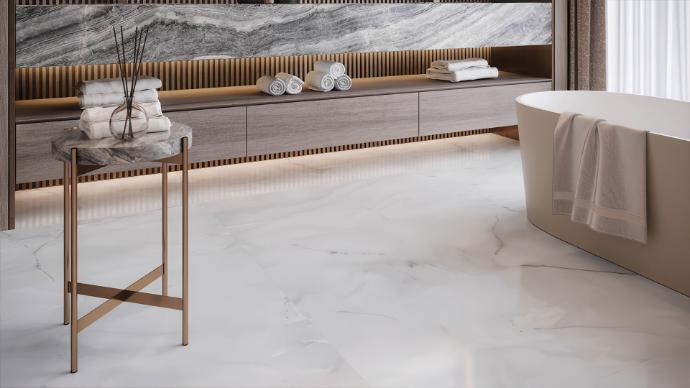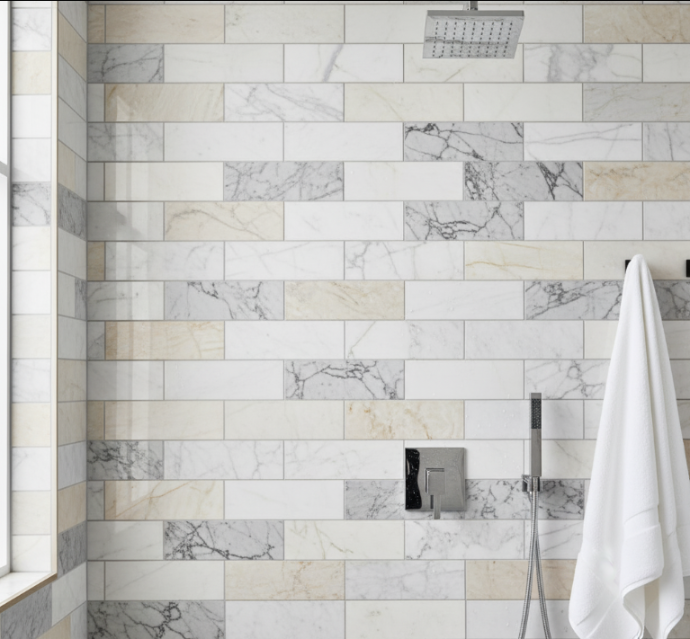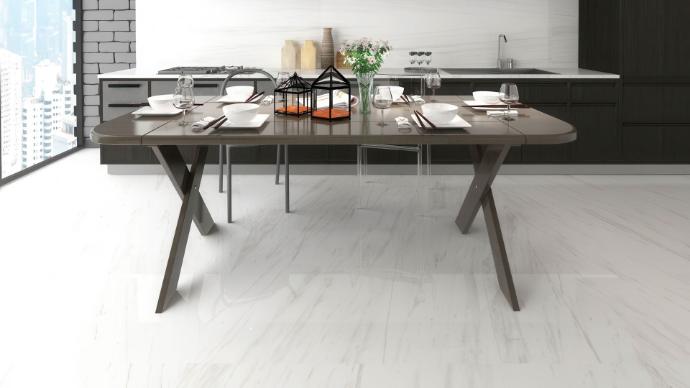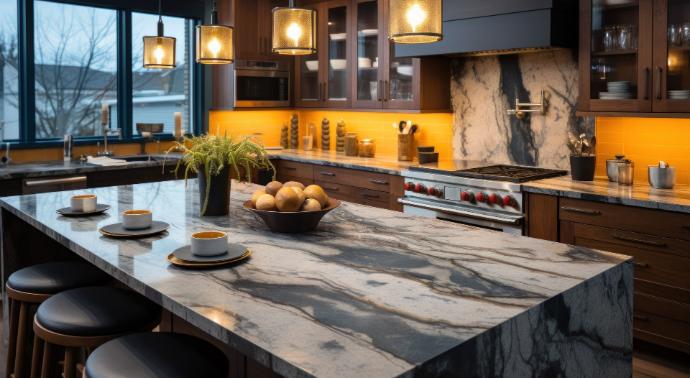Yes, marble and subway tile go together exceptionally well, creating a sophisticated design combination that balances luxury with practicality. This pairing works because marble's natural veining and premium appearance complement subway tile's clean lines and functional design, resulting in spaces that feel both elegant and approachable.
Combining marble with subway tile creates a powerful design statement in modern interiors. This strategic pairing merges marble's luxurious character with subway tile's practical elegance, delivering spaces that feel both refined and welcoming.
Marble brings natural veining and lustrous surfaces that signal premium quality. Subway tile provides sleek, contemporary lines and functional beauty. Merge these materials to achieve an engaging interplay of surface treatments and visual textures. Throughout this guide, discover how marble and subway tile complement each other, explore actionable design strategies, and learn the essential factors for successfully integrating these materials into your living spaces.
Overview of Marble and Subway Tile
Marble stands as a metamorphic stone created through extreme heat and geological pressure, celebrated for its premium look and structural resilience. Natural mineral deposits create its signature veining patterns, delivering distinction and visual appeal to every installation. From pristine white to dramatic black, marble's color spectrum provides diverse design possibilities when you shop tiles by color.
Featured prominently in countertops, floors, and backsplash applications, marble's enduring aesthetic drives its popularity across residential and commercial projects, representing elegance and high-end taste.
Subway tile, defined by its straightforward rectangular profile and crisp edges, dominates contemporary interior applications. First introduced in New York City's underground transit system, this tile format earned recognition for its robust performance, easy upkeep, and accessible pricing. Choose from diverse colors, surface treatments, and dimensions to match design approaches ranging from streamlined to classic. Beyond kitchens and bathrooms, subway tile enhances mudrooms, laundry areas, and main living quarters. Browse through options when you shop tiles by size to find the perfect dimensions for your project.
When combined, marble and subway tile generate an impressive fusion of surface qualities and visual elements. Marble's richness establishes a commanding design anchor, while subway tile delivers equilibrium and visual structure. This pairing gains momentum as design professionals and property owners pursue interiors that merge aesthetic excellence with everyday practicality.
Pros and Cons of Combining Marble and Subway Tile
Integrating marble with subway tile delivers aesthetic impact alongside functional realities. Evaluate the key strengths and limitations before implementing this material combination in your space.
Advantages of Pairing Marble and Subway Tile
Merging marble and subway tile unlocks multiple design and performance benefits:
Elegant and High-End Appeal
Pairing marble with subway tile injects sophisticated luxury into your environment. Marble's organic veining and glossy surface harmonize with subway tile's geometric precision, producing a polished, attention-grabbing visual statement.
Versatility in Design Styles
This material duo adapts seamlessly across diverse design directions, from contemporary to traditional aesthetics. The contrasting surface treatments and finishes between marble and subway tile introduce dimension and visual engagement, making this combination effective for both current trends and timeless classics. When you shop tiles by style, you'll discover options that complement any design vision.
Durability and Long-Lasting Materials
Marble and subway tile both deliver proven longevity and structural integrity. As natural stone, marble handles demanding use effectively. Subway tile, commonly manufactured from glazed ceramic, offers durability with straightforward cleaning. Together, these materials establish resilient, low-effort interiors that meet NKBA planning guidelines for quality installations.
Disadvantages of Pairing Marble and Subway Tile
While this material pairing offers compelling advantages, consider these practical limitations:
Marble Requires More Maintenance
Despite its beauty, marble demands greater care than subway tile. This stone proves vulnerable to etching and discoloration, particularly when contacted by acidic materials. Plan for consistent cleaning routines and regular sealing to preserve its appearance and protect against deterioration.
Price Differences
Marble carries substantially higher costs compared to subway tile, especially for premium grades or extensive coverage. Account for this price gap carefully when budgeting projects that incorporate both materials. Industry insights from ceramic tile market research indicate growing demand for quality materials that offer both aesthetics and value.
Potential Clash If Not Coordinated Properly
Though marble and subway tile can achieve visual harmony, success requires careful attention to color selection, texture matching, and design cohesion. Poor coordination between these materials produces visually jarring results.
Design Tips for Combining Marble and Subway Tile
Creating visual balance with marble and subway tile demands strategic planning. Apply these design principles to maximize both materials and develop cohesive, attractive interiors:
Color Palette
Color selection dramatically shapes your space's character when merging marble and subway tile. Opt for the timeless black and white approach, where dark marble veining provides striking contrast against bright white subway tile. Create warmer, inviting environments by selecting neutral marble tones like beige or cream alongside subway tiles in harmonizing hues. Inject personality with bold marble or subway tile accents in rich blues, emerald greens, or intense reds.
Texture and Pattern
Mixing varied textures and patterns between marble and subway tile adds spatial depth and visual complexity. Pair marble with geometric-patterned subway tile featuring subtle herringbone or chevron arrangements. This approach generates dynamic, visually compelling spaces that express style and originality. Explore various subway tile pattern layouts to find arrangements that enhance your design and create visual interest.
Layout and Placement
Strategic positioning of marble and subway tile fundamentally influences your space's overall design impact. Use marble as your primary focal element, consider fireplace surrounds or kitchen countertops. Deploy subway tile to establish a unified, complementary background. Alternatively, position marble as accent features in backsplashes or shower enclosures, with subway tile forming primary surface coverage. When you shop tiles by type, consider how different material formats impact your layout options.
Lighting
Appropriate lighting amplifies the beauty of marble and subway tile, emphasizing their distinct textures and color variations. Leverage natural light to showcase marble's veining and pattern details. For artificial illumination, install recessed fixtures or wall-mounted sconces to deliver gentle, uniform brightness. Test various lighting angles to establish different atmospheres and visual moods throughout your space.
Different Spaces for Combining Marble and Subway Tile
Marble and subway tile demonstrate adaptability across multiple home areas. From kitchen zones to bathroom retreats, explore specific locations where this combination delivers maximum impact.
Kitchen
Kitchens represent popular venues for incorporating marble and subway tile. Deploy marble for countertop surfaces and subway tile for backsplash areas to establish a functional, elegant kitchen that balances beauty with utility. Consider porcelain subway tiles on kitchen island walls, integrating marble accents into countertops or as decorative focal points for a cohesive design.
Bathroom
Bathrooms provide ideal environments for combining marble and subway tile. Install marble flooring to inject luxury and refinement, while subway tile walls or shower enclosures generate clean, modern appeal. Achieve design unity by placing subway tiles in shower areas and marble on vanity surfaces. Transform your bathroom into a spa-inspired sanctuary with this combination. For comprehensive guidance on material selection, consult this bathroom flooring guide and review inspiring bathroom remodel ideas from leading design professionals.
Entryways and Utility Spaces
Apply marble and subway tile effectively in entrance areas and utility rooms. Marble flooring establishes durable, stylish surfaces that withstand heavy foot traffic. Add subway tile walls to introduce color and texture while maintaining practicality and simple maintenance. This pairing creates welcoming, impressive first impressions for visitors. To explore suitable materials for these high-traffic areas, review the products we carry at our showroom.
Accent Walls and Feature Areas
Add dramatic impact to your home by incorporating marble and subway tile into accent walls or standout features. Combine a marble fireplace surround with subway tile walls to create a stunning living room centerpiece. Position a marble accent wall in bedrooms to introduce luxury and sophistication. For unique complementary accent options, explore terrazzo mosaic tile options that beautifully enhance marble and subway tile installations.
How Marble and Subway Tile Fit Different Styles
Marble and subway tile adapt to both contemporary and traditional interior design approaches. Achieve successful results by understanding each style's defining characteristics and choosing appropriate materials and finishes.
Modern Spaces
In modern environments, marble and subway tile combinations produce sleek, sophisticated aesthetics. Implement streamlined subway tile patterns like herringbone or chevron alongside marble for minimalist luxury. Pair darker subway tile shades such as black or charcoal with white or grey-veined marble for contemporary edge. This combination introduces drama and visual intrigue while preserving clean, current sensibilities. Browse ceramic subway tiles to find modern finishes that perfectly complement your design vision.
Traditional Homes
Within traditional settings, marble and subway tile establish timeless, elegant atmospheres. Match classic white subway tile with heavily veined marble to evoke luxury and refinement. Apply traditional layout patterns, including staggered subway tile arrangements, combined with marble countertops or accent elements to strengthen the traditional aesthetic. This pairing provides visual continuity and harmony while adding contemporary flair. To appreciate the artistry behind quality tiles, learn about handmade ceramic tile techniques and the craftsmanship involved in tile production.
Transitional Spaces
For those favoring blended modern and traditional elements, transitional spaces offer perfect opportunities to incorporate marble and subway tile. Select neutral subway tile shades paired with softer, less dramatic marble designs to create harmonious, inviting atmospheres. Mix classic elements like marble with contemporary subway tiles featuring unique characteristics resembling wood or natural stone to add personality and visual interest. This combination enables eclectic, personalized designs reflecting individual style preferences.
Pattern and Layout Options When Pairing Marble and Subway Tile
Pattern and layout choices for marble and subway tile combinations determine your room's visual impact. Explore creative approaches that highlight each material's distinctive characteristics.
Classic Staggered Layout with Marble Accents
Achieve timeless elegance by combining traditional staggered subway tile layouts with marble accent elements. The conventional subway tile arrangement creates beautiful contrast with marble's natural irregularity, producing visually interesting, dynamic compositions. Incorporate marble for decorative components like borders, inlays, or accent elements within subway tile patterns, adding luxury and sophistication. Consider how bullnose tile applications can provide finished edges and professional-looking transitions for your installation.
Herringbone or Chevron Patterns
For contemporary aesthetics, implement herringbone or chevron patterns using subway tile. These arrangements inject movement and visual intrigue into your space. Combined with marble, they generate sophisticated, eye-catching designs. Position marble as borders or inlays within herringbone or chevron patterns, or as contrasting elements in the overall composition. The Perfection 2.5x8 matte porcelain subway tile works exceptionally well for creating precise geometric patterns with consistent dimensions.
Alternating Tiles
Create bold, statement-making designs by alternating marble and subway tile within single areas. This produces striking, attention-commanding patterns that draw focus to the space. The contrast between marble's natural veining and subway tile's geometric lines adds drama and visual engagement.
Practical Considerations
When merging marble and subway tile, evaluate several practical factors affecting installation, maintenance, and overall project costs.
Installation
While subway tile often suits DIY approaches, consulting professionals yields optimal results, particularly for complex patterns or extensive areas. Professionals ensure proper alignment and premium finishes. Reference Ceramic Tile Foundation installation resources for best practices and technical guidance on proper installation techniques. Marble typically demands professional expertise due to its delicate characteristics and intricate veining. Properly cutting and installing marble presents challenges, and color and pattern variations require careful planning to achieve cohesive, visually appealing outcomes. For detailed instruction and helpful techniques, review this guide on tile replacement that applies to both materials.
Grout Color Considerations
Grout color selection significantly influences overall appearance when combining marble and subway tile. Lighter grout colors emphasize marble's natural veining and patterns, while darker grout generates dramatic, contrasting effects. Carefully evaluate both marble and subway tile colors when selecting grout to ensure harmonious, visually satisfying results. Master the application process with this comprehensive grouting tile tutorial before beginning your project to achieve professional-quality results.
Maintenance and Durability
As noted earlier, marble demands greater maintenance compared to subway tile. Plan for regular sealing to protect surfaces from stains and etching, especially in frequently used areas or spaces with high acidic substance exposure. Ceramic or porcelain subway tile generally offers straightforward cleaning and maintenance. Use mild detergents and avoid harsh chemicals to prevent finish damage.
For long-term durability, both marble and subway tile withstand heavy use and suit high-moisture environments like bathrooms and kitchens. Seal marble regularly to prevent water penetration and staining.
Cost Considerations
Combined marble and subway tile costs vary based on specific materials selected, project scope, and installation complexity. Marble carries higher costs than subway tile, particularly for premium varieties or large quantities. Balance expenses by deploying marble for smaller accent zones and subway tile for broader coverage. Carefully evaluate your budget and design preferences to create beautiful, functional spaces without exceeding financial limits.
Alternatives to Marble
While marble delivers timeless, elegant aesthetics, several alternative materials achieve similar appearances.
Marble Look Tiles
Ceramic and porcelain tiles with marble-look finishes provide affordable, durable alternatives to natural marble. Available in numerous colors, patterns, and textures, these tiles enable homeowners to capture marble's elegance without associated costs and maintenance requirements.
Pros
Marble look tiles deliver cost-effective, durable alternatives to natural marble, providing luxurious aesthetics without premium price points. Manufactured from ceramic or porcelain, these tiles resist scratches, stains, and water damage, making them suitable for active areas. Unlike natural marble, they require minimal maintenance, eliminating regular sealing needs and offering easy cleaning.
Cons
Marble look tiles may lack the unique, natural variations found in genuine marble, which can disappoint those seeking authentic, one-of-a-kind appearances. While closely resembling marble, some consumers prefer the authentic look and tactile quality of natural stone.
Quartzite
Quartzite represents a natural stone merging marble's elegance with enhanced durability. Its intricate veining and diverse color variations create premium aesthetics, making it sought-after for countertops, backsplashes, and flooring. Unlike marble, quartzite highly resists scratches and etching, offering practical solutions for high-traffic areas.
Pros
Quartzite's durability makes it excellent for kitchens and bathrooms where surfaces endure frequent use. Its natural heat resistance ensures it withstands hot cookware without damage. With extensive color and pattern ranges, it provides sophisticated aesthetics mimicking marble while requiring less maintenance. Though sealing remains necessary, quartzite's lower porosity reduces deep staining likelihood, simplifying upkeep.
Cons
Despite its advantages, quartzite requires periodic sealing to maintain stain and moisture resistance. Its hardness, while beneficial for durability, complicates cutting and installation, often requiring professional expertise. Availability can prove limited, and costs tend to exceed alternatives like porcelain or subway tiles. While more affordable than premium marble options, it remains an investment in both material and installation.
Large Format Porcelain Tiles
Large format porcelain tiles offer seamless, modern alternatives to both marble and subway tile. With fewer grout lines, they create clean, expansive appearances that enhance spatial perception in any room. These tiles provide minimalist aesthetics with solid colors and subtle textures.
Pros
Large format porcelain tiles provide versatile design solutions, available in finishes including matte, grip, and polished surfaces. Their low-maintenance nature makes them attractive marble alternatives, as they're non-porous, stain-resistant, and easy to clean. Additionally, their durability ensures moisture, scratch, and everyday wear resistance, making them excellent for busy areas.
Cons
Due to their size, large format porcelain tiles require precise installation to ensure flawless finishes. Professional installation proves often recommended, especially for intricate layouts or wall applications. Their weight may require additional support in certain areas, but proper planning mitigates this concern. Despite these factors, their long-term durability and aesthetic appeal make them worthwhile investments.
The Perfect Pairing of Marble and Subway Tile
Combining marble and subway tile offers versatile, sophisticated aesthetics that elevate any interior environment. Their contrasting textures, marble's luxurious veining paired with subway tile's clean lines create balanced, visually appealing designs. While factors like maintenance and cost require consideration, thoughtful planning ensures these materials harmonize beautifully, enhancing both traditional and modern spaces. Whether deployed in kitchens, bathrooms, or feature walls, this pairing delivers timeless elegance with practical functionality.
To help you achieve the perfect blend of these materials, consult with our experts for design services tailored to your unique style and space. Our team provides personalized guidance, helping you select from an extensive range of marble look tiles and options from our subway tile collection to create cohesive, stylish interiors. With our design expertise, you can confidently transform any room into a sophisticated and functional space that reflects your vision.
Conclusion
Marble and subway tile form a winning combination that transforms ordinary spaces into extraordinary environments. This pairing successfully balances luxury with practicality, offering design flexibility that adapts to your unique vision and lifestyle needs. Take action by carefully planning your color schemes, evaluating your budget constraints, and considering maintenance requirements before starting your project.
Start your design journey by identifying which spaces in your home would benefit most from this sophisticated material combination. Assess whether you prefer marble as the dominant feature or as strategic accents that enhance subway tile installations. Research local professionals who specialize in natural stone and ceramic tile installation to ensure flawless execution of your vision, or shop local options to support nearby suppliers and see materials in person.
Consider visiting showrooms to experience the tactile qualities of different marble varieties and subway tile finishes firsthand. Test various grout colors against your selected materials to preview the final aesthetic impact. Develop a maintenance plan that includes regular sealing schedules for marble surfaces to protect your investment long-term. Explore our collection to discover the full range of premium tiles and natural stone options available for your project.
Whether renovating a single bathroom or redesigning your entire home, the marble and subway tile combination delivers lasting value and visual appeal. Take the first step today by consulting with design experts who can guide you through material selection, layout planning, and installation strategies. Transform your living spaces with confidence, knowing this timeless pairing will continue to impress for years to come.
Ready to bring your marble and subway tile vision to life? Contact us to receive personalized design consultation and explore our extensive showroom. Learn more about our company and discover why homeowners trust our experienced team to help navigate every decision, from initial concept to final installation, ensuring your project exceeds expectations.
Frequently Asked Questions
Can I install marble and subway tile together in a shower?
Yes, combining marble and subway tile in shower applications creates stunning, spa-like environments. Install marble on shower floors or as accent bands, while using subway tile for primary wall coverage. Ensure proper waterproofing behind both materials and seal marble surfaces regularly to prevent water damage and staining. Choose non-slip marble finishes for floor applications to maximize safety in wet conditions.
What grout color works best when pairing marble with white subway tile?
Light grey or warm beige grout complements marble and white subway tile combinations effectively. These neutral tones highlight marble's natural veining without creating harsh contrasts that compete with the stone's patterns. Avoid pure white grout, which shows dirt quickly and can appear stark. Test grout samples on actual tile surfaces before committing to ensure the color enhances rather than overwhelms your design.
How do I clean marble and subway tile without damaging the marble?
Clean both materials using pH-neutral cleaners specifically formulated for natural stone. Avoid acidic cleaners like vinegar or lemon-based products that etch marble surfaces. For subway tile, standard ceramic cleaners work well, but when cleaning areas with both materials, use the gentler marble-safe products throughout. Wipe spills immediately on marble surfaces and perform regular cleaning with soft microfiber cloths to maintain both materials' appearance.
Is marble and subway tile suitable for high-traffic kitchen areas?
Marble and subway tile work well in high-traffic kitchens with proper care and maintenance. Position subway tile in backsplash areas where it requires minimal upkeep, while using sealed marble for countertops or islands. Honed marble finishes show wear less obviously than polished surfaces in busy kitchens. Reseal marble countertops regularly in high-use areas to maintain stain resistance and durability.
Can I use marble look tiles instead of real marble with subway tile?
Absolutely, marble look porcelain or ceramic tiles pair excellently with subway tile while offering enhanced durability and lower maintenance requirements. Modern marble look tiles replicate natural stone's veining and color variations convincingly at reduced costs. This combination provides the sophisticated aesthetic of marble and subway tile without the extensive care demands of natural stone. Choose high-quality marble look tiles with varied patterns to achieve the most authentic appearance.
What's the cost difference between using real marble versus marble look tiles with subway tile?
Real marble typically costs more than marble look porcelain tiles when installed. Subway tile generally falls in the moderate price range. Combining real marble accents with subway tile strategically controls costs, use authentic marble for small focal areas and subway tile for broader coverage. Marble look tiles offer budget-friendly alternatives that achieve similar aesthetics at substantially lower price points while reducing long-term maintenance expenses.



